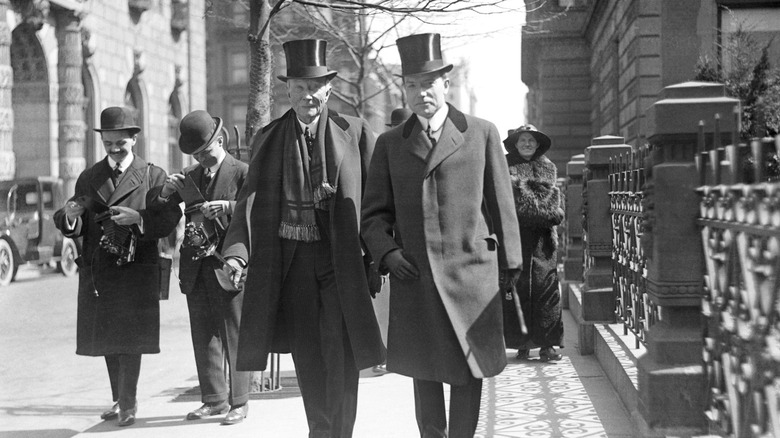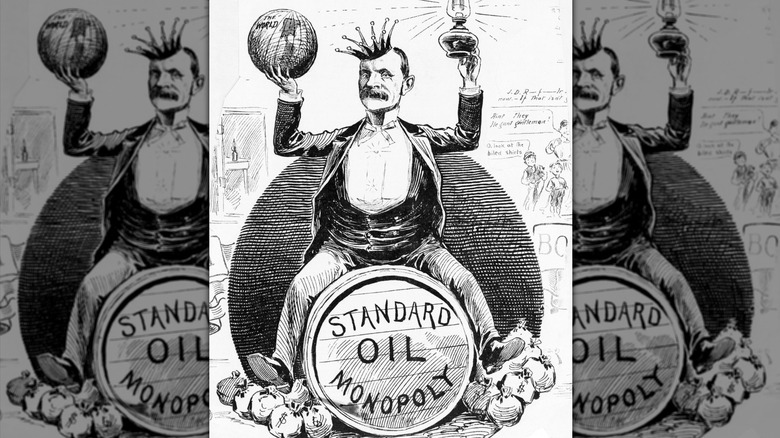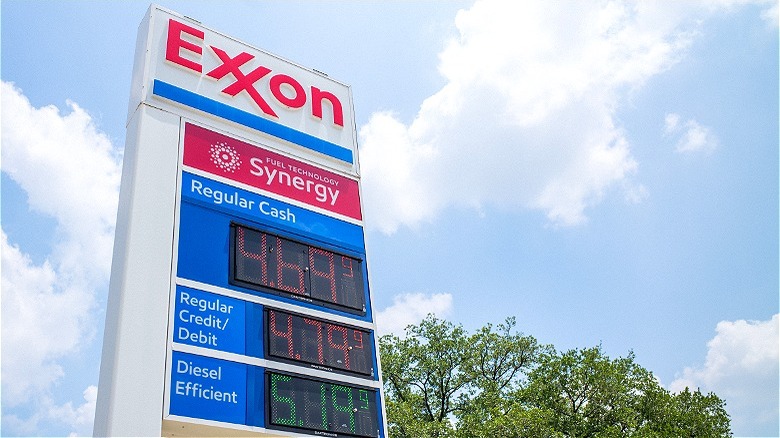The Dark History Behind The World's First Billionaire
While you have probably heard the phrase "rich as a Rockefeller," you might not have realized just how rich that was (let alone how much money distant Rockefeller relatives continue to enjoy today). Among the many historically problematic and wealthy families in American history, the Rockefeller name is a particularly famous standout. This fortune and fame are largely due to one family member in particular, John D. Rockefeller, founder of the infamous Standard Oil Company. With famous New York buildings still bearing the Rockefeller name, and a slew of companies that only exist today due to the uniquely shrewd business practices of the Standard Oil Company, it should come as a surprise to no one that John D. Rockefeller was the world's first billionaire.
However, what might come as a surprise is how exactly Rockefeller achieved his billionaire status. Despite humble beginnings, Rockefeller got involved with the oil business in 1863 when he was just 24 years old. However, he soon bought out his business partners, struck a deal with a major railroad, and officially formed the Standard Oil Company in 1870 with $1 million in capital. At the time of its creation, the company was the largest corporation in the entire country, controlling 10% of all U.S. petroleum refining (eventually reaching 90%). Despite moving to Cleveland's "Millionaires' Row" and creating one of the country's most famous monopolies, it wouldn't be until 1916 (and a landmark Supreme Court decision later) that Rockefeller would officially become a billionaire.
Background
The Standard Oil Company began buying out, bankrupting, and acquiring its competitors in 1872. This was due in large part to John D. Rockefeller's belief that having multiple companies attempting to undercut each other (also known as free-market capitalism) created chaos and inefficiency. He effectively eliminated 22 of the 26 competitors he had in the Cleveland market in just three months. As the Standard Oil Company's monopoly grew, so did the company's ability to negotiate discounts and pricing that further hurt competitors. By being able to guarantee steady and plentiful oil loads, Standard Oil carved out incredible railroad agreements, which competitors were unable to compete with. (Read about five pros and five cons of a monopoly.)
As the company continued to grow, it eventually had a network of Standard Oil companies, all of which were part of what became known as the Standard Oil Trust. This trust controlled 90% of all of America's oil refineries by the late 1880s, drawing the attention of politicians who were increasingly concerned about antitrust laws. The press also became increasingly interested in Rockefeller (who at this time wasn't yet a billionaire), with numerous critiques centering on his unfair labor practices, supposed bribery and coercion, and even accusations of threats.
In 1890, the United States Congress officially passed the Sherman Antitrust Act, the first federal legislation that prohibited the creation of trusts that intentionally restricted trade. Two years later, the Ohio Supreme Court first ordered the dissolution of the Standard Oil Trust. However, the businesses comprising the trust simply "moved," becoming part of a holding company, Standard Oil of New Jersey, instead. It would take years of legislation to finally dismantle Standard Oil.
Rockefeller fortune
It wasn't until the U.S. Supreme Court ruled, in 1911, that Standard Oil had violated antitrust laws that the company would finally start to be dismantled. Note that John D. Rockefeller had technically been retired for some 16 years at that point, though he maintained his title as president of Standard Oil up until six months after the Supreme Court's decision. As the dissolution suit moved forward, the government filed a list of Standard Oil stockholders, which included, of course, Rockefeller. At the time, the government found that Rockefeller held 247,692 shares (roughly one quarter of the total stock of the company), valued at a staggering $167,192,000 (but obviously less than a billion). In addition, thanks to many years of behind-closed-door deals with railroads and other companies, Rockefeller also held considerable stock in railroad companies across the country.
As noted, it was actually in the breaking up and selling off of his company's entities that Rockefeller achieved his billionaire status. In fact, if not for the Supreme Court's decision, it would be someone else who would hold the title of the country's first billionaire. The Standard Oil monopoly ended up being broken into 34 separate companies, many of which are still recognizable names today (such as ExxonMobil and Chevron), and many of which still actively affect our gas prices. The shares of these individual companies exploded in value in their first few years of operation, catapulting Rockefeller's wealth into the billionaire category. In 1937, Rockefeller's fortune was worth 1.5% of the country's total economic output for the entire year. (See who were some of the richest people during the Great Depression.)


